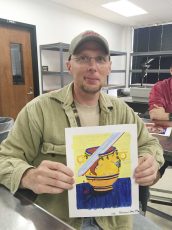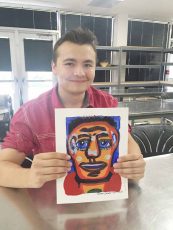By Michelle Winters/ reporter

Photos courtesy Earline Green
South art assistant professor Earline Green found some “hidden jewels” in her spring Art Appreciation class but didn’t know they had the same opinion of her.
Since TCC non-art majors can no longer take studio art courses to fulfill their fine arts credit on their degree plan, Green was concerned they were missing an important opportunity.
“Art should be therapeutic,” she said.
Students often speak through their artwork, revealing things about themselves in a non-threatening manner, Green said. Now that studio classes are out of the core curriculum, students may miss the chance to explore other art forms that would provide an outlet that better suits them.
“I can’t teach creativity without giving choices,” she said.
Green, who usually teaches ceramics, said the solution was to incorporate a hands-on studio style into her Art Appreciation lesson plan. She considers the results remarkable.
As with any other traditional class, students heard lectures, watched videos and had reading assignments. But the class moved from the ordinary.

“We drew an eyeball on the first day of class,” environmental science major Miranda Ehrgott said.
Green asked students to use their cellphones to take a picture of their eye and begin drawing what they saw. From there, they began an unexpected journey into the art world they said was a welcome and pleasant surprise. The students learned about architecture, history, artifacts and civilization.
“She didn’t just teach about art,” biology major Keila Horton said. “She covered a huge amount of information.”
James Kupchuno decided to pursue a degree in biology after serving 20 years in the Navy. He said he never liked art, but his opinion changed during Green’s class.
“I grew to have an appreciation for art,” he said. “Now, I know it actually takes talent.”
While most of the students registered for the class because it was required, many discovered a hidden talent and zeal for art they may have otherwise never realized. Others, like Kupchuno, gained a deeper appreciation for art.
Ehrgott said though she was interested in taking other art classes, she said she’s terrified of student debt.
“I wanted to take an art class to learn how to draw, but my G.I. Bill wouldn’t pay for it,” she said.
Through Green’s Art Appreciation class, Ehrgott was able to quench that thirst. She, along with the other students, learned about lighting and color schemes and how to draw basic shapes, forms, lines, textures, depths and shading. They were also required to follow a contemporary artist during the semester, taking that artist with them throughout the art movement.
Green told her students that the currently popular Zentangle is a combination of Zen, which means peaceful state of mind, and tangle, which means state of confusion.

“These two cannot coexist this beautifully anywhere else but art,” she said.
Using techniques they learned in class, the students were asked to create line design problems. They were to work on them for one hour each week but only when they were calm. That state of “mindlessness,” as Green calls it, opened a realm of endless possibilities. She said an explosion of creativity resulted.
Green said the students were so eager to learn and create art that it invigorated her.
“The more they wanted, the more I wanted to be able to give them,” she said. “I want them to know how special they are.”
Ehrgott said this was the one class she looked forward to attending. Green greeted everyone with a smile and a pleasant attitude every day. And though students were required to learn the material, she made it fun. Ehrgott said Green’s best quality is her genuine interest in her students.
“She really cares about us,” Ehrgott said. “And she does everything she can to give us the tools we need to succeed.”
Elizabeth Sprowls said the greatest benefit she received from the class was the ability to express herself. The assignment that impacted her the most was the self-portrait.

The students had to take “selfies” and choose one to draw. Sprowls took several angles of her face then picked the one that spoke to her. She called it “Emphasis on Skinniness.” Sprowls, who has had on ongoing battle with being underweight, used her self-portrait
to reveal pain.
“It takes a lot to look at myself in the mirror and say I’m still beautiful,” she said.
Green’s students said they discovered a new form of relaxation through art.
“I didn’t teach them [to create art],” she said. “I just gave them an opportunity. The gift was already there.”





























